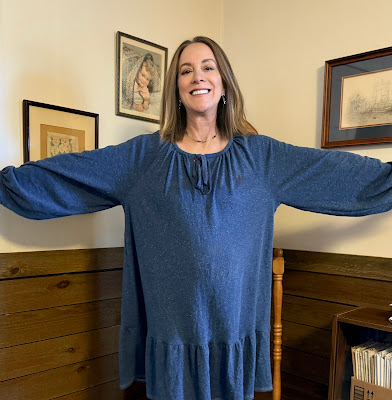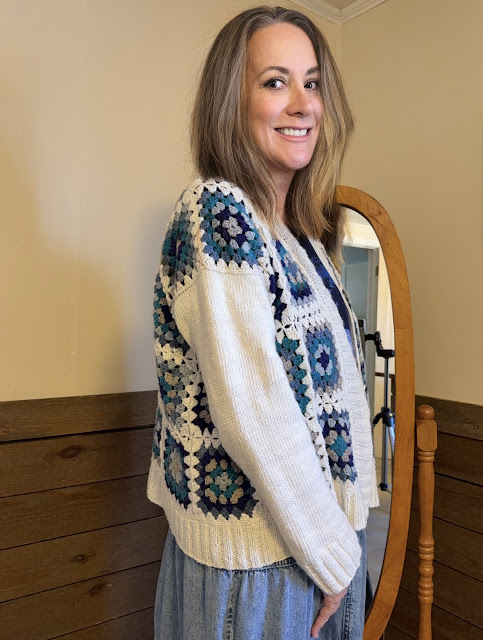The knit dresses for summer project continues with a 3/4 length sleeve dress, cut from 3 yards of gray cotton/poly/spandex interlock purchased for $28.73 at JoAnn's. After cutting, there was about a yard left. There is also a 32" piece of the same fabric found in the remnant bin for $2.34. With the two pieces combined, there's probably enough for another dress, or at least a t-shirt. I will miss JoAnn's remnant bin.
The pattern is a simple dolman sleeve dress or shirt, Simplicity R10180. This is one of their "hacking" patterns that offers several suggestions for gathering the sleeves or side seams. In the back of my closet I found an old wearable toile from another dolman dress cut from Butterick 6525. It is well-worn and headed for the discard pile. Since it is similar in shape but several inches larger in the side seams, it served as a toile for the Simplicity pattern. Once it was cut to pattern dimensions and resewn, it looked like a medium would work. So an old toile became a new toile.
Construction was surprisingly simple and quick. The dress was done in a day, probably 2-3 hours total. There's just 2 pattern pieces.
Since it was the first time I had made a dress from this pattern, I changed from narrow zig zag to basting stitch after the side notches on the body. After a try on, I narrowed the seams to 3/8" from 5/8" from the notch to 8" below the notch for a little more ease and pulled out the basting. In the future, I would just repeat that adjustment or cut that area a little wider in the front. Once I make that adjustment, I can use lightning stitch or the serger for all the seams.
Up until now, the hems were sewn with a twin needle, with mixed results. Really, a twin needle works fine on some fabrics that don't do well with a simple topstitched hem or even a blind hem. However, most knits tunnel with a twin needle. Some finer gauge knits both tunnel and bias against the stitching.
Above is an example, a shirt from a couple of years back. It didn't look too bad after hemming, even with the bit of tunneling. Over time, the hem biased. Whether it is due to the cutting or to the stitching will be determined now that the twin needle hem has been replaced with a coverstitch hem.
As mentioned in my last post, I have a new coverstitch machine. After coverstitching the hem of my recent Roscoe dress, I decided I could use more practice. Besides not being instant magic, the coverstitch machine takes much more practice than the serger. It works well, but since the hems are visible, it is important that the stitching be straight and evenly connected. With a serger, the stitching is hidden inside the garment, along with any uneven or crooked stitching.
Above is the new hem on the old shirt. Once it is washed, we shall see if it biases. The neckline of the old shirt was replaced with a neat new neckband (I have more of this fabric, as you will see in my next post.) that was coverstitched down. It would have worked out well but the fabric has only mechanical stretch, no recovery. The neckband stands up a bit too much. That's one more reason to throw this worn-out shirt away--after I wash it and check the hems.
The coverstitching was acceptable, but it is not magic. It doesn't change the basic characteristics of fabric. The hem of the Roscoe dress is turning up, as does every 5/8" or narrower hem I do. Ah, well. (A quick fix is to put clothespins on the hem when it is hung to dry. Then iron it. Even if you dry it in the dryer, putting the clothespins before hanging and then ironing before wearing helps.) However, I have found that the coverstitch machine is more intuitive and easier to understand than the serger. I have never threaded my serger. It came threaded, so tying on a new color and pulling it through the machine, then threading the needle is all that I have had to do the change thread. I planned the purchase to avoid threading the serger.
I thought I might be able to treat the coverstitch machine the same way, avoiding the difficulty of threading. I purchased 4 spools of thread at the dealer and persuaded the sales associate to thread the machine while I watched. Then I carefully packed it and brought it home threaded. My luck didn't hold. I was forced to re-thread the looper when it came partially unthreaded. Fortunately, I was able to follow the guide in the manual and remember what the sales associate demonstrated. I have also had to thread it for 2 needle coverstitching and then back to 3 needles. However, the needle thread follows a simple pattern through the color coded guides across the machine. I think that coverstitch machines are much like sewing machines, except that they have more needles and the bobbin is replaced by a looper. As a result, they seem much easier to thread than sergers.

For this pattern, the cuffs, hem and neck are all just turned under and sewn down. With my Bernette 42, I coverstitched them. The gray ITY knit is easy to handle and hem. My only misgiving is the dolman sleeves. They do wrinkle.


















